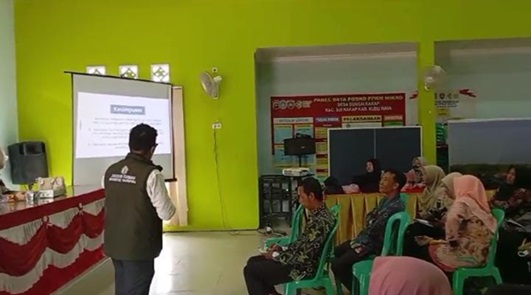Edukasi SWADAIA: Swamedikasi Dispepsia Berbasis Kasus dan Video pada Masyarakat Desa Sungai Kakap, Kabupaten Kubu Raya SWADAIA Education: Case and Video Based Dyspepsia Self-Medication in the Sungai Kakap Village Community, Kubu Raya Regency
Main Article Content
Abstract
The prevalence of dyspepsia in Sungai Kakap Village is ranked third largest based on data from the Sungai Kakap Community Health Center, Kab. Kubu Raya with an incidence of 1,636 cases in 2023. One of the problems experienced by dyspepsia patients is inappropriate self-medication or self-medication. This Community Service Activity (PKM) is aimed at PKK members and Posyandu cadres because they are part of the community and are also an extension of health workers in helping solve problems experienced by dyspepsia patients. The method used in this PKM is case-based and educational videos. This PKM activity consists of several activities including preparation of activities; orientation and coordination of activities; selecting the target audience for educational media creation activities; providing pre-tests and cases at the beginning of activities; providing educational materials; discussion; post-test; evaluation of activity implementation; and data analysis. The output of this community service is publication in local electronic media in West Kalimantan (Suara Pemred/Tanjungpura Times), publication of scientific articles in the Sinta 4 accredited journal " PengabdianMu ", Copyright of educational videos and videos of implementation of activities on the FK UNTAN YouTube channel. The overall results obtained were an increase in knowledge of 27.19% with an average pre-test score (60.6) and post-test score (77.08). According to the evaluation of activities through questionnaires, participants considered the material presented to be very interesting, and the learning media provided was considered to provide new knowledge.
Downloads
Article Details

This work is licensed under a Creative Commons Attribution-ShareAlike 4.0 International License.
Authors who publish with this journal agree to the following terms:
- Any article on the copyright is retained by the author(s).
- Author grant the journal, right of first publication with the work simultaneously licensed under a Creative Commons Attribution License that allows others to share work with acknowledgment of the work authors and initial publications in this journal.
- Authors are able to enter into a separate, additional contractual arrangements for non-exclusive distribution of published articles of work (eg, post-institutional repository) or publish it in a book, with acknowledgment of its initial publication in this journal.
- Authors are permitted and encouraged to post their work online (e.g., in institutional repositories or on their websites) prior to and during the submission process, as can lead to productive exchanges, as well as earlier and greater citation of published work.
- The article and any associated published material is distributed under the Creative Commons Attribution-ShareAlike 4.0 International License
References
Abdelwahed, R. N. K., Jassem, M., & Alyousbashi, A. (2022). Self-Medication Practices, Prevalence, and Associated Factors among Syrian Adult Patients: A Cross-Sectional Study. Journal of Environmental and Public Health, 2022. https://doi.org/10.1155/2022/9274610
Bell, J., Dziekan, G., Pollack, C., & Mahachai, V. (2016). Self-Care in the Twenty First Century: A Vital Role for the Pharmacist. Advances in Therapy, 33(10), 1691–1703. https://doi.org/10.1007/s12325-016-0395-5
Dewan Jaminan Sosial Nasional, & BPJS Kesehatan. (2019). Statistik JKN 2014-2018: mengungkap fakta dengan data. Retrieved from https://djsn.go.id/files/dokumen/Dokumen Kajian/202104151516 Statistik JKN 2014-2018_PDF E-Book_Cetakan Pertama(DJSN - BPJS Kesehatan).pdf
Ford, A. C., & Talley, N. J. (2014). Epidemiology of Dyspepsia. GI Epidemiology: Diseases and Clinical Methodology: Second Edition, 158–171. https://doi.org/10.1002/9781118727072.ch15
Lee, C. H., Chang, F. C., Hsu, S. Der, Chi, H. Y., Huang, L. J., & Yeh, M. K. (2017). Inappropriate self-medication among adolescents and its association with lower medication literacy and substance use. PLoS ONE, 12(12), 1–14. https://doi.org/10.1371/journal.pone.0189199
National Institute for Health and Care Excellence. (2014). Dyspepsia and Gastro-oesophageal Reflux Disease : Clinical Guideline. National Institute for Health and Care Excellence, 1(9), 7. Retrieved from https://www.nice.org.uk/guidance/cg184/evidence
Rutter, P. (2015). Self Care Swamedikasi WHO. Integrated Pharmacy Research and Practice, 57.
Shaghaghi, A., Asadi, M., & Allahverdipour, H. (2014). Predictors of self-medication behavior: A systematic review. Iranian Journal of Public Health, 43(2), 136–146.
Syam, A. F. (2005). Uninvestigated dyspepsia versus investigated dyspepsia. Acta Medica Indonesiana, 37(2), 113–115.
Syam, A. F., Miftahussurur, M., Makmun, D., Abdullah, M., Rani, A. A., Siregar, G. A., Yamaoka, Y. (2023). Management of dyspepsia and Helicobacter pylori infection: the 2022 Indonesian Consensus Report. Gut Pathogens, 15(1), 1–19. https://doi.org/10.1186/s13099-023-00551-2
